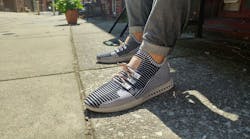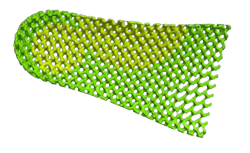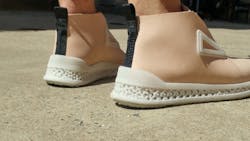3D printing offers many advantages for custom-made products, from improving unique consumer experiences to saving time and money during the manufacturing and design process. Rapid prototyping of parts also enables mass customization of products and reduces the waste often created through traditionally manufactured molds, making them a sustainable choice for designers.
Shoes created using these processes are particularly effective in tailoring sole designs to the unique needs of wearers, from shape and comfort to gait and specific applications like sports. With many large shoe manufacturers using 3D printing to offer distinctive products, what are some of the main areas for concern in 3D printing the best custom shoes, and which approaches are the most effective at delivering production savings and consumer benefits?
1. Data Acquisition
Custom printing better shoes begins with a scan of the customer’s feet. This data is used to create uniquely contoured soles that enable proper ergonomic support and a natural gait. The best results come when a range of different requirements are combined, with additional sources including podiatrists and footwear professionals. Foam impression kits are also useful, in this respect, for quickly acquiring a mold that can be scanned to begin creating the custom footwear.
From the scans a CAD file is created and the complete midsole is connected.
Casts provided by podiatrists can also be used when designing footwear for orthopedic problems. Other potential ways in which this information may be collected in the future include scanning apps. However, there is a higher risk of problems with measurement accuracy and consistency when using this approach to collect information.
2. Ensuring Accuracy
The accuracy of 3D image data is crucial to getting the right custom shoes, whereby the geometry of the foot needs to be accurately reconstructed in software. Compared to generic data, 3D scanning of feet means that subject-specific products can be designed that are more comfortable and tailored to the particular requirements of the wearer. Some of the best results come from working with tools that allow 3D image data of feet to be easily combined with CAD software, where designs can be quickly tested out to decide on the best approach for customers without the need for using multiple software packages. It is also important here to ensure that CAD and STL files are ready to be sent directly to 3D printing processes, with no need for repair. Failing to do this can produce printing problems and wasted materials.
3. Optimizing with Lattices
Companies like Footprint 3D are achieving particular design successes by using lattice tools in software such as Simpleware to customize soles for customers—this involves increasing or decreasing lattice volume and node thickness to add flexibility or increase support in certain areas, such as the heel or arch, from pressure map data. Lattice structures are also ideal for testing out different types of flexible TPU (thermoplastic polyurethane) and other elastomeric material, as they allow for significant design freedoms when looking at areas from orthopedic soles to running shoes and everyday walking.
The yellow sections of the sole are adjusted to provide increased stiffness and support.
While some companiesare able to 3D-print custom shoes on the same day, this approach often lacks the range of data and the design testing enabled by software design optimisation and the use of lattices. A super-fast process doesn’t always produce the most accurate results, particularly given the high risk of small errors affecting the 3D printing process. Fast but careful design work with a customer’s data is therefore an important part of avoiding any defects that might undermine the value of a custom shoe.
4. Cost-Effective 3D Printing
Once the model has been prepared, it can be sent to a 3D-printing process. Selective laser sintering (SLS) is often used for its accuracy and suitability in working with TPU powder and polyurethane to create a finished product that is both durable and waterproof. The unique particle bonding of this approach means that energy can be more evenly dispersed throughout the shoe and foot, and at a slower rate than with traditional manufacturing.
However, SLS printing methods can be costly and include post-processing demands, as well as a relatively limited number of suitable materials. By comparison, fused deposition modeling (FDM) is less expensive and achieves similar results without the need for significant additional work after printing. Keeping the workflow straightforward for 3D printing custom shoes is crucial to ensuring that the services and products are still affordable. Resin-based systems could also eventually be a viable method, although for now FDM and other approaches like fused filament fabrication production arguably represent the most cost-effective solution for customizing soles.
5. Recycling Materials and Future Challenges
By not needing to use molds to test out different designs, a virtual approach employing software and 3D printing is able to cut down on waste and only use the optimal amount of materials. Another way to save time and money on the manufacturing process is to swap out soles from existing shoes to the new ones, whereby the upper sole can be fitted to a shoe to help test outsole and midsole designs.
Here is a finished product with altering density and a custom fit. (Footprint 3D; Synopsys).
During manufacturing, it is also possible to use a vacuum bag as a low-cost alternative to a hydraulic press; this method creates high pressure contact on all sides for gluing. Soles can then be combined with the rest of a shoe to create a unique product that is ready to be used by the customer. Keeping these costs down and maintaining an economic process does, however, mean having to keep an eye on potential problems with the printing process. For example, when working with very precise designs, any small defects can upset the printing, adding more costs to the overall work. While the hydraulic press is superior, it's also very costly and not necessary. Vacuum bagging can be used to quickly adhere the upper to the printed sole in prototyping.
The ongoing goal for 3D printing better custom shoes is to reduce the amount of material waste as much as possible, while exploring new and existing methods for rapid customization of digital models for every customer. Getting the soles printed within a day of an order is one ideal target, as are keeping defects in the manufacturing process as low as possible to ensure a quick turnaround from receiving customer data to design optimization, production, and delivery to customers.



